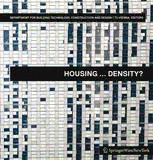
Housing Density PDF
Preview Housing Density
~ SpringerWienNewYork Housing Density Department for Building Construction and Design – HB2 Institute of Architecture and Design Vienna University of Technology Editor 2012 SpringerWienNewYork Housing Density SpringerWienNewYork is a part of Springer Science + Business Media Published by www.springer.at Vienna University of Technology Institute of Architecture and Design Printed on acid-free and chlorine-free Department for Building Construction bleached paper and Design – HB2 Gerhard Steixner SPIN: 80015906 Head of department T +43 / 1 / 588 01 270 26 This work is subject to copyright. http://www.hb2.tuwien.ac.at All rights are reserved, whether the whole or part of the material Editorial work is concerned, specifically those Gerhard Steixner of translation, reprinting, re-use of Polina Petrova illustrations, broadcasting, repro- Laura Hannappel duction by photocopying machines or Linda Rukschcio similar means, and storage in data Vera Kumer banks. Translation Product Liability: The publisher can Lucie Motloch give no guarantee for all the infor- mation contained in this book. The use Proofreading of registered names, trademarks, etc. Christoph von Pohl in this publication does not imply, even in the absence of a specific statement, Graphic design that such names are exempt from Büro Ferkl the relevant pro t ective laws and regulations and therefore free for Print general use. Rema Print, Vienna One volume with numerous color and Copyright black-and-white illustrations. authors, architects, students, photographers Library of Congress Control Number: 2011 944 827 © 2012, Department for Building Construction and Design – HB2 ISBN 978-3-7091-0358-6 Vienna University of Technology / SpringerWienNewYork Springer-Verlag, Wien Content Preface Gerhard Steixner 10 Interviews The interviews were conducted by Maria Welzig and Gerhard Steixner Harry Glück 20 Roland Rainer 30 Projects 41 – 179 Appendix 182 Floor Space Index 0.32 0.50 0.65 Project BBQ Village Con[Trans] Living Watzespitze Students Laura Untertrifaller Markus Göschl Rebecca Bremer Alena Preldzic Nicole Neumayr Instructor Adele J. Gindlstrasser Ulrike Hausdorf Silvia Boday Page 41 51 61 Projects 1.00 1.10 1.35 1.40 Courtyard House³ Frame Story The Inner World Fabian Antosch Stefan Kristoffer Emanuel Bührle Eva Liisa Freuis-Manhart Mauricio Duda Susanne Mariacher Melanie Hosner Helene Schauer Marius Nechville Feria Gharakhanzadeh Eva Cˇeška Martina Schöberl Franziska Orso 71 81 91 101 Floor Space Index 1.65 1.70 2.50 Project 45.425277° / 12.327219° Green Modules Green Crossover Students Johannes Ritsch Viktoria Jiru Michael Strodl Sarah Wantoch Christian Daschek Maximilian Bauböck Instructor Kinayeh Geiswinkler-Aziz Marlies Breuss Ursula Schneider Page 111 121 131 Projects 2.50 2.70 2.82 3.00 Housing Square Living Density Wood on a Higher Level Cracked Bernd Hattinger Annika Hillebrand Isabell Ausserer Emeli Steinbacher Fabian Lutter Philipp Rudigier Alexandra Stummer Johann Szebeni Susanne Fritzer Maria Flöckner Katharina Fröch Gerda Maria Gerner 141 151 161 171 The Greatest Number Gerhard Steixner Housing construction for the greatest number is Repeated efforts since the First World War to an important indicator of the social character of achieve cost-effective, ecological and socially sus- a society. Most people want to live in a single-family tainable construction – and buildings to serve as house. In the Netherlands, in England or in Japan, examples thereof – show that the problem is not a this wish is largely being taken into account. In lack of knowledge, but of competitive mechanisms contrast to these countries, the simple row house and, because of other interests, a lack of will to or the high-density, low-rise building has yet to implement this knowledge. be established as a cost-effective form of building However, we as architects cannot bridge the gap in Austria. The percentage of apartment buildings between constructed reality and the users’ desires in Austria is 60% and the construction costs are on our own. Housing construction is urban devel- correspondingly higher than in the aforementioned opment and therefore a category of the political. countries. After the First World War, Vienna’s first city counci- A high percentage of the population not only has lor for housing declared that, given the city’s many to be content with an unwelcome type of housing, tenement blocks from the “Gründerzeit” 4, only but as a result of a low ownership rate also has single-family houses would be built in the future. to bear even higher expenses in the form of rising Josef Frank and Adolf Loos were the protagonists rents. of the Vienna Settlers’ Movement which attempted “Housing is a basic need for all, as well as an to promote the incipient democratization of socie- important social and economic matter of fact. A ty in the area of public housing. Low development roof over one’s head is expensive – the owner- densities, spacious gardens and communal facilities ship of a house or an apartment can be expensive such as swimming pools, kindergartens, libraries, due to construction or purchase, but in the long laundry and healthcare facilities were characteristic term poses less of a financial burden; renting features of the “superblocks” 5 of Red Vienna built in volves continually rising costs. In general, these in the thirties of the last century. costs belong to the most significant household After the Second World War, Roland Rainer con- expenditures.” 1 tinued the efforts to provide livable housing. His The result is a low level of housing and life writings 6 on housing issues laid the groundwork for satis faction, both in absolute terms as well as in a the Europe-wide search for alternatives to the Europe-wide comparison. 2 Declining birth rates, status quo in housing construction and urban de- high social and healthcare costs, and the increased velopment that resurfaced in the mid-sixties. New popularity of so-called protest parties 3 are a clear forms of urban housing 7 were developed as an indication of the necessity for a paradigm shift answer to the perimeter block and the row house. when it comes to housing. High-density low-rise buildings and – in response to the call for higher density – terrace complexes 10
